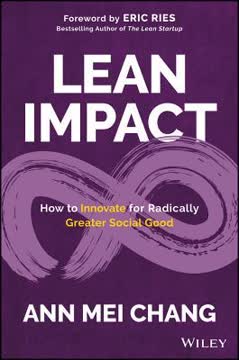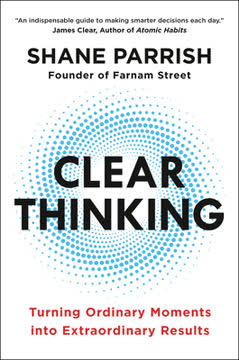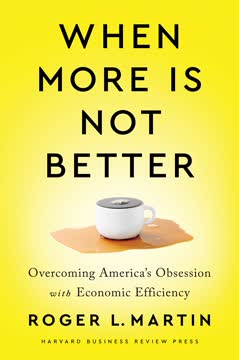Key Takeaways
1. Social entrepreneurship targets equilibrium change, not just incremental improvement
Social entrepreneurs seek to go beyond better, to bring about a transformed, stable new system that is fundamentally different than the world that preceded it.
Transformative change. Social entrepreneurs aim to shift entire systems, not just improve existing conditions. They target unhappy equilibriums - stable but unjust situations that marginalize or exclude segments of society. Unlike social service providers who ameliorate problems or social advocates who lobby for change, social entrepreneurs take direct action to create new, more optimal equilibriums.
Characteristics of social entrepreneurship:
- Identifies a stable but inherently unjust equilibrium
- Develops an equilibrium-shifting solution with social value
- Creates a new, sustainable equilibrium that releases trapped potential
Examples like Muhammad Yunus's Grameen Bank demonstrate how social entrepreneurs can fundamentally transform systems, in this case providing access to credit and financial services for millions of poor people previously excluded from the banking system.
2. Understanding the current system is crucial before attempting transformation
The paradox of social transformation is that one has to truly understand the system as it is before any serious attempt can be made to change it.
Deep system knowledge. Successful social entrepreneurs invest significant time and effort in understanding the current equilibrium before attempting to change it. This involves navigating three key tensions:
- Abhorrence vs. appreciation: Balancing outrage at injustice with curiosity about why the system persists
- Expertise vs. apprenticeship: Leveraging existing knowledge while humbly learning from those in the system
- Experimentation vs. commitment: Testing ideas while maintaining focus on the ultimate goal
Molly Melching's work with Tostan in Senegal illustrates this approach. By deeply immersing herself in Senegalese culture and communities for years, she gained the insights needed to effectively address issues like female genital cutting in a culturally sensitive way.
3. Envisioning a new future requires specificity and adaptability
Social entrepreneurs envision a stable and sustainably transformed world that exists on a new, substantially healthier plane for that targeted population and, often, for society at large.
Clear, compelling vision. Effective social entrepreneurs articulate a specific vision of a transformed future equilibrium. This vision should:
- Target a defined beneficiary group while considering the broader system
- Describe a compelling, superior future state
- Remain adaptable as conditions change
The vision serves as a north star, guiding all subsequent efforts. For example, Riders for Health envisioned a future where reliable transportation systems enable consistent healthcare delivery across Africa. This specific yet systemic vision drove their development of innovative fleet management solutions.
4. Building a model for change involves reengineering the value equation
Successful social entrepreneurs must build their models for change with both cost and value in mind, challenging assumptions and finding mechanisms that turn a losing value equation into a winning one.
Value equation transformation. Social entrepreneurs create models that fundamentally alter the economics of the system they seek to change. They can:
- Enhance value: e.g., creating transparency standards or measurement rubrics
- Reduce costs: e.g., lowering capital or operating expenses
Key mechanisms include:
- Adding customer value through transparency (e.g., GoodWeave's rug certification)
- Adding government value via measurement (e.g., Pratham's ASER education survey)
- Enhancing value of existing assets (e.g., One Acre Fund's farmer training)
- Reducing capital costs by borrowing assets (e.g., Imazon using NASA satellites)
- Investing in platforms to lower operating costs (e.g., Kiva's microlending platform)
- Substituting lower-cost labor (e.g., APOPO's landmine-detecting rats)
- Creating low-cost products/services (e.g., Proximity Designs' affordable irrigation tools)
5. Scaling solutions demands intentional design and systemic approaches
Scale, even when defined explicitly as scale of impact rather than scale of organization, is hard to achieve. It is the stage that marks the true equilibrium shift, and is the stage at which many would-be social entrepreneurs fail.
Deliberate scaling strategies. To achieve widespread impact, social entrepreneurs must:
- Design for economies of scale
- Take a systemic approach, leveraging other ecosystem actors
- Use open-source models that encourage replication
Successful scaling often involves:
- Documenting the model to enable replication
- Refining the approach over time based on feedback and results
Partners In Health exemplifies effective scaling through its community-based care model. By partnering with local organizations and governments, PIH has expanded its impact far beyond what it could achieve alone, transforming health systems across multiple countries.
6. Successful social entrepreneurs navigate key tensions in their work
Social entrepreneurs must navigate three powerful tensions in understanding the world they wish to change: abhorrence and appreciation; expertise and apprenticeship; and experimentation and commitment.
Balancing act. Effective social entrepreneurs skillfully manage opposing forces:
- Abhorrence vs. Appreciation: Maintaining outrage at injustice while deeply understanding the current system
- Expertise vs. Apprenticeship: Leveraging existing knowledge while humbly learning from those in the system
- Experimentation vs. Commitment: Testing new approaches while staying focused on the ultimate goal
These tensions arise throughout the social entrepreneurship process, from understanding the world to scaling solutions. Navigating them requires self-awareness, adaptability, and a willingness to embrace paradox.
7. Social entrepreneurship fills the gap between government and business innovation
Social entrepreneurship negotiates these constraints.
Bridging sectors. Social entrepreneurship offers a distinctive approach to driving change, filling the space between government-led and business-led transformation.
Key differences:
- Government: Mandatory, ubiquitous, driven by social benefit
- Business: Voluntary, limited, driven by profit
- Social Entrepreneurship: Combines elements of both to address challenges ill-suited to either sector alone
Social entrepreneurs like Nandan Nilekani (Aadhaar unique ID program in India) demonstrate how principles from both government and business can be creatively combined to tackle complex social challenges. By operating in this hybrid space, social entrepreneurs can drive innovations that neither government nor business alone could achieve.
Last updated:
FAQ
What's Getting Beyond Better about?
- Focus on Social Entrepreneurship: The book delves into how social entrepreneurs are transforming societies by addressing systemic issues and creating sustainable solutions.
- Framework for Change: Authors Roger L. Martin and Sally R. Osberg provide a structured framework for social entrepreneurship, including understanding the world, envisioning a new future, building a model for change, and scaling solutions.
- Real-World Examples: It is rich with case studies of successful social entrepreneurs, illustrating how they have disrupted the status quo to create meaningful change in various sectors.
Why should I read Getting Beyond Better?
- Inspiration for Changemakers: The book serves as a motivational guide for anyone interested in making a difference, offering insights into the mindset and strategies of successful social entrepreneurs.
- Practical Framework: Readers gain access to a structured approach to social entrepreneurship, applicable in various contexts, whether in nonprofit work, business, or community organizing.
- Timely Relevance: As the world faces numerous social challenges, the book provides essential lessons on how to effectively address these issues through innovative thinking and action.
What are the key takeaways of Getting Beyond Better?
- Understanding Equilibrium Change: The authors emphasize the need to identify and understand stable but unjust equilibriums that perpetuate social issues.
- Social Entrepreneurship Defined: It is defined as creating systemic change through innovative solutions that address root causes of social problems, rather than merely alleviating symptoms.
- Four Stages of Transformation: The book outlines a four-stage process: understanding the world, envisioning a new future, building a model for change, and scaling the solution.
What are the best quotes from Getting Beyond Better and what do they mean?
- Risk and Action: “To try to make the future is highly risky. It is less risky, however, than not to try to make it.” This underscores the importance of taking action to create change, even in the face of uncertainty.
- Beyond Incremental Change: “Social entrepreneurs seek to go beyond better, to bring about a transformed, stable new system that is fundamentally different than the world that preceded it.” This highlights the mission of creating lasting change.
- Identifying Injustices: “The identification of a stable but inherently unjust equilibrium that causes the exclusion, marginalization, or suffering of a segment of humanity.” This defines the starting point for social entrepreneurs.
How does Getting Beyond Better define social entrepreneurship?
- Transformative Action: Social entrepreneurship is the process of identifying and addressing stable but unjust equilibriums that cause suffering or exclusion.
- Direct and Indirect Actions: The authors distinguish between direct actions taken by social entrepreneurs and indirect actions that advocate for change.
- Sustainable Solutions: The goal is to create sustainable systems that provide ongoing benefits to society, rather than temporary fixes to social problems.
What is the four-stage model for social entrepreneurship in Getting Beyond Better?
- Understanding the World: This involves a deep analysis of the current system, identifying the forces that maintain the status quo.
- Envisioning a New Future: Entrepreneurs articulate a compelling vision for change that addresses the needs of their target constituency.
- Building a Model for Change: Focuses on creating a sustainable model that effectively addresses the identified issues.
- Scaling the Solution: Emphasizes the importance of expanding the impact of the model to reach a broader audience.
How do social entrepreneurs envision a new future according to Getting Beyond Better?
- Systemic Approach: They must envision a future that addresses the needs of their primary beneficiaries and considers the broader system.
- Compelling Vision: The vision should articulate a clear and compelling future state that represents a significant improvement over the current equilibrium.
- Adaptability: Successful social entrepreneurs remain adaptable, allowing their vision to evolve based on feedback and changing circumstances.
How does Getting Beyond Better address the concept of equilibrium change?
- Equilibrium as a Stable State: Describes equilibrium as a balanced system that persists without intentional action to shift it.
- Identifying Unjust Equilibriums: Emphasizes recognizing stable but unjust equilibriums that cause suffering as the first step toward creating effective solutions.
- Creating New Equilibriums: Argues that social entrepreneurs must work to establish new, stable equilibriums that provide ongoing benefits to society.
What role does collaboration play in social entrepreneurship as discussed in Getting Beyond Better?
- Collective Effort: Effective social change often requires collaboration among various stakeholders.
- Building Partnerships: Social entrepreneurs are encouraged to form partnerships with governments, businesses, and communities.
- Shared Goals: Collaboration fosters a shared understanding of goals and objectives among stakeholders, crucial for driving systemic change.
What challenges do social entrepreneurs face according to Getting Beyond Better?
- Navigating Complex Systems: They often operate within complex systems that are resistant to change.
- Securing Funding: Access to capital is a significant hurdle, requiring demonstration of model viability to attract investors and donors.
- Measuring Impact: Quantifying social impact can be difficult, necessitating effective metrics to assess progress and communicate success.
What are some examples of successful social entrepreneurs mentioned in Getting Beyond Better?
- Paul Farmer: Co-founder of Partners In Health, providing high-quality healthcare in impoverished regions.
- Riders for Health: Focuses on improving healthcare delivery in Africa by managing transportation logistics for health workers.
- Kailash Satyarthi: Founder of GoodWeave, working to eliminate child labor in the carpet industry through a certification system.
How can I apply the lessons from Getting Beyond Better in my own work?
- Identify Unjust Equilibriums: Analyze systems to identify stable but unjust equilibriums that need addressing.
- Develop a Compelling Vision: Articulate a clear vision for change that addresses the needs of your target constituents.
- Experiment and Adapt: Be willing to experiment with different approaches and adapt strategies based on feedback and changing circumstances.
Review Summary
Getting Beyond Better: How Social Entrepreneurship Works receives mixed reviews, with an average rating of 3.92/5. Readers appreciate its insights into social entrepreneurship, framework for creating change, and case studies. Some find it inspiring and educational, while others criticize its density and writing style. The book is praised for its introduction to the field but critiqued for accessibility and potential oversimplification of complex issues. Many readers recommend it for those interested in social impact, though some suggest it may be more suitable for academic or specialized audiences.
Similar Books










Download PDF
Download EPUB
.epub digital book format is ideal for reading ebooks on phones, tablets, and e-readers.








